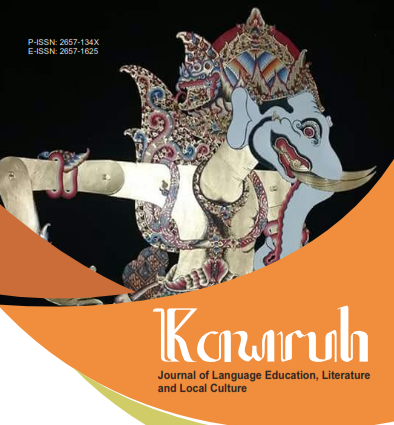The Cultural Values of the Bedhah Bumi Heirloom Withdrawal Tradition in Gunungkidul from the Perspective of Symbolic Anthropology
DOI:
https://doi.org/10.32585/kawruh.v7i1.6514Abstract
The purpose of this study is to provide an in-depth explanation of the cultural values contained within the Bedhah Bumi heirloom retrieval tradition in Gunungkidul. This research also aims to contribute to the body of knowledge on culture, in order to ensure that Javanese culture—particularly traditions specific to certain areas—continues to be preserved. This study employs a qualitative research method. The research subject consists of the sole family that has inherited the leadership of the Bedhah Bumi heirloom retrieval tradition. The object of the research is the Bedhah Bumi heirloom retrieval tradition located in Kalurahan Gari, Kapanewon Wonosari, Gunungkidul Regency. Data were collected through observation and interviews. The collected data were then analyzed using a descriptive method. The validity of the data was ensured through theoretical validity, and its reliability was assessed through stability reliability. The results of this study reveal the cultural values embedded in the Bedhah Bumi heirloom retrieval tradition. The cultural values identified in this research include: the value of the relationship between humans and God, the value of the relationship between humans and nature, the value of the relationship between humans and society, the value of interpersonal relationships, and the value of the relationship between humans and themselves.
Downloads
References
Adung Abdur Rohman. (2020). “Isi Kandungan Al-Mulk Dan Al-Wai’ah Dan Korelasinya Dengan Konsep Keberkahan Hidup.” Jurnal Iman Dan Spiritualitas 1 (33): 272–79.
Ahmad, Ichsanudin, Bagas Syafrijal N, Ajeng Octa N, and Avatara Rizky P. (2021). “Tradisi Upacara Sekaten Di Yogyakarta.” Kawruh: Journal of Language Education, Literature and Local Culture 3 (2): 49. https://doi.org/10.32585/kawruh.v3i2.1718.
Ale Sandya Rindi Amida, Yuli Kurniati Werdiningsih, and Sunarya. (2024). “Struktur Dan Fungsi Mantra Tradisi Nyapih Di Desa Karangwotan Kecamatan Pucakwangi Kabupaten Pati.” Kawruh: Journal of Language Education, Literature and Local Culture 6 (2): 103–10. https://doi.org/10.32585/kawruh.v6i2.5814.
Ayatullah Humaeni. (2012). “Makna Kultural Mitos Dalam Budaya Masyarakat Banten.” Antropologi Indonesia 33 (3).
Bambang Subahri, and Ahmad Arif Ulin Nuha. (2022). “BUDAYA PANDALUNGAN SEBAGAI MEDIA PENDIDIKAN EGALITER.” Bidayatuna 5 (2).
Budiono Harusatoto. (2008). Simbolisme Jawi. Yogyakarta: Ombak.
Edward Djamaris. (1996). Nilai Budaya Dalam Karya Sastra Nusantara. Jakarta: Pusat Pembinaan dan Pengembangan Bahasa Departemen Pendidikan dan Kebudayaan.
Eleazer, Julio, Nendissa Teologi, / Program, Studi Magister, and Sosiologi Agama. (2022). “TEORI KONFLIK SOSIOLOGI MODERN TERHADAP PEMBENTUKAN IDENTITAS MANUSIA.” Journal Jurnal Pendidikan Sosiologi Universitas Pendidikan Ganesha Jurusan Sejarah, Sosiologi Dan Perpustakaan. Vol. 4.
FX Rahyono. (2009). Kearifan Budaya Dalam Kata. Jakarta: Wedatama Widya Sastra.
Hanafi, Arman, and Muhammad Yasin. (2023). “Upaya Memperkuat Hubungan Sosial Dalam Kehidupan Bermasyarakat.”
J Lexy Maleong. (2010). Metode Penelitian Kualitatif Edisi Revisi. Bandung: PT Remaja Rosdakarya.
Jonathan Roberge. (2016). “What Is Critical Hermeneutics?” Sage 105 (1).
Luwiyanto, M. Mukhtasar Syamsuddin, and Lasiyo. (2025). “Konsep Keseimbangan Dalam Wayang Tauhid Lakon ‘Wedhare Sadat Tembayat’ Sajian Ki Sunardi Wirocarito.” Kawruh: Journal of Language Education, Literature and Local Culture 6 (2): 123–31. https://doi.org/10.32585/kawruh.v6i2.5763.
Maryaeni. (2005). Metode Penelitian Kebudayaan. Jakarta: PT Bumi Aksara.
Matsudaira, Tomomi. (2006). “Measures of Psychological Acculturation: A Review.” Transcultural Psychiatry 43 (3): 462–87. https://doi.org/10.1177/1363461506066989.
M. Muslich, Ks. (2004). “Pandangan Hidup Dan Simbol-Simbol Dalam Budaya Jawa.” Millah: Journal of Religious Studies 3 (2).
Nurjannah Sintya Sihotang, Megawati Manullang, and Warseto Freddy Sihombing. (2023). “Penghormatan Terhadap Leluhur: Perspektif Masyarakat Batak Kristen Terhadap Ritual Mangongkal Holi Di Desa Sinom Hudon Tonga.” Lumen: Jurnal Pendidikan Agama Katekese Dan Pastoral 2 (2): 65–79. https://doi.org/10.55606/lumen.v2i2.213.
Nurmalasari, Eka. (2023). “NILAI KEARIFAN LOKAL UPACARA PETIK LAUT MUNCAR SEBAGAI SIMBOL PENGHARGAAN NELAYAN TERHADAP LIMPAHAN HASIL LAUT.” Vol. 10. https://jurnal.unigal.ac.id/index.php/artefak/article/view/9749.
Paul Bohannan. (1995). How Cultural Works. United States of America: Library of Congress Cataloging in Publication.
Puddin, Ali, Al Ubaidillah, and Bagus Wahyu Setyawan. (2021). “Pengaruh Budaya Dan Tradisi Jawa Terhadap Kehidupan Sehari-Hari Pada Masyarakat Di Kota Samarinda.” Jurnal Adat Dan Budaya 3.
Ramli, Yusri Mohamad. (2012). “Agama Dalam Tentukur Antropologi Simbolik Clifford Geertz.” International Journal of Islamic Thought 1 (June):62–73. https://www.proquest.com/scholarly-journals/agama-dalam-tentukur-antropologi-simbolik/docview/1773262949/se-2?accountid=31324.
Richley H Crapo. (2002). Cultural Anthropology. United States of America: Library of Congress Cataloging in Publication Data.
S Nasution. (2003). Metode Penelitian Naturalistik Kualitatif. Bandung: Tarsito.
Sukandi. (2006). Penelitian Kualitatif Naturalistik Dalam Pendidikan. Yogyakarta: Usaha Keluarga.
Syamsudin Saleh. (2014). “Agama, Kepercayaan, Dan Kelestarian Lingkungan Studi Terhadap Gaya Hidup Orang Rimba Menjaga Lingkungan Di Taman Nasional Bukit Dua Belas (TNBD) Jambi.” Jurnal Kawistara 4 (3).
Syamsul Bahri, and Maezan K. Gibran. (2015). “Tradisi Tabuik Di Kota Pariaman.” Jurnal Online Mahasiswa Fakultas Ilmu Sosial Dan Ilmu Politik Universitas Riau 2 (2).
Watsiqotul, Sunardi, and Leo Agung. (2018). “Peran Manusia Sebagai Khalifah Allah Di Muka Bumi Perspektif Ekologis Dalam Ajaran Islam.” Lembaga Penelitian Dan Pengabdian Kepada Masyarakat Institut Agama Islam Negeri Kudus 12 (2).
Downloads
Published
How to Cite
Issue
Section
License
Copyright (c) 2025 Alfian Anggoro Mukti, Endang Nurhayati, Suwardi, Azis Heru Iswanto

This work is licensed under a Creative Commons Attribution-ShareAlike 4.0 International License.
Authors who publish with the Kawruh: Journal of Language Education, Literature and Local Culture agree to the following terms:
- Authors retain copyright and grant the journal the right of first publication with the work simultaneously licensed under a Creative Commons Attribution License (CC BY-SA 4.0) that allows others to share the work with an acknowledgment of the work's authorship and initial publication in this journal.
- Authors are able to enter into separate, additional contractual arrangements for the non-exclusive distribution of the journal's published version of the work (e.g., post it to an institutional repository or publish it in a book), with an acknowledgment of its initial publication in this journal.
- Authors are permitted and encouraged to post their work online (e.g., in institutional repositories or on their website) prior to and during the submission process, as it can lead to productive exchanges, as well as earlier and greater citation of published work.

